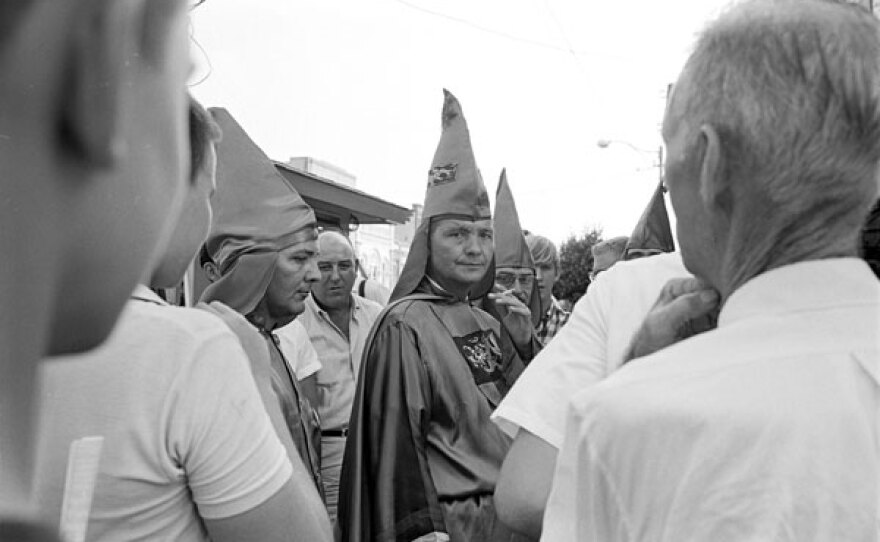Discover the incredible characters and epic stories that have shaped America’s past and present. Television’s most-watched history series, acclaimed by viewers and critics alike, has been honored with every major broadcast award.






Top 5 Questions About the KKK
AMERICAN EXPERIENCE asked sociologist and Ku Klux Klan scholar David Cunningham to provide responses to the five questions he is most frequently asked about the Klan. The author of "Klansville, U.S.A.: The Rise and Fall of the Civil Rights-Era KKK" (Oxford University Press, 2013), Cunningham is Professor and Chair of Sociology at Brandeis University.
As the civil rights movement grew, the long-dormant Ku Klux Klan gained momentum as well, having reemerged after the 1954 Supreme Court Brown v. Board of Education decision. That the Klan would rise once again wasn’t surprising, but where the reincarnation took place was. North Carolina, long considered the most progressive southern state and one whose image was being burnished by the enormously popular THE ANDY GRIFFITH SHOW, saw a boom in Klan membership under the leadership of Bob Jones, the most successful Grand Dragon in the country.
In just three years, he grew the North Carolina Klan from a handful of friends to some 10,000 members––more than the Klans of all other southern states combined. In the process, Jones helped give the Tarheel State a new nickname: “Klansville, U.S.A.” Produced and directed by Callie T. Wiser, "Klansville U.S.A." premieres on AMERICAN EXPERIENCE on Tuesday, January 13, 2015 on PBS.
Born in Pulaski, Tennessee in 1865, the Ku Klux Klan was established by decommissioned Confederate soldiers following the Civil War. Initially formed as a fraternal social club, the group quickly became violent, and had begun to dissolve in 1871 under pressure from the federal government. In 1915, D.W. Griffith’s "The Birth of a Nation" romanticized the Klan, portraying their violence towards African Americans as justifiable and necessary to restore order in a chaotic South. The enormous popularity of the film sparked a Klan revival in the 1920s, and by 1925, four million Americans claimed membership. But bad press and power struggles tore the group apart in the 1930s.
In the 1960s, as lunch counter sit-ins and other civil rights demonstrations began to spread, officials in several southern states reacted swiftly and defiantly as the movement gained momentum. But North Carolina leaders advocated for a moderate approach, and Bob Jones, whose father had been a Klan member in the 1920s, feared that the state’s leaders would not resist the push for integration. In the summer of 1963, he petitioned the United Klans of America for a charter to organize in his home state, and on August 17, Jones was chosen to be the group’s first Grand Dragon.
Two weeks later, American TV sets were filled with images of the undeniable power of the growing civil rights movement at the March on Washington. Three days after the March, on August 31, Jones held a rally of his own in a cornfield near his hometown of Salisbury, hoping to attract a few hundred people. Two thousand showed up.
Tapping into the fears and resentments of low-income whites who believed that a changing America would leave them behind, Jones took his message across the state, establishing Klaverns and signing up hundreds of members. He teamed up with George Dorsett, an ordained Baptist minister who became the Klan’s official chaplain and whose powerful sermons complemented Jones’ organizational skills.
Hoping to turn the Klan into a political force, Jones tried to organize the more than ten thousand members into a powerful voting bloc. To show that his Klan had nothing to hide, he planned marches in broad daylight, and processions of unmasked robed Klansmen, plainclothes supporters, wives, and children took to the streets. They quickly grew to be the largest Klan organization in the nation. While his empire was built on hate-filled rhetoric and white supremacy, Jones publicly advocated nonviolence as a strategy to avoid the wrath of the FBI and federal authorities.
Ultimately, events from inside and outside the North Carolina Klan combined to bring down Jones’ empire: the blatant murder of a white civil rights worker from Detroit by Alabama Klan members, and the ability of the FBI to turn members of Jones’ inner circle into informants against him.
“When we talk about the Klan now we tend to think about the horrific violence that occurred in Alabama or Mississippi,” said Callie T. Wiser. “But if we think that racism only shows itself as violent acts or cross burning, then we can miss the fact that, as in North Carolina, a more subtle and perhaps more insidious form of racism can still lurk within American social and political structures.”
“What we’ve tried to do in Klansville is offer a 360-degree perspective, shifting the focus from those who supported the civil rights movement to those who saw integration and social change as a threat to their way of life,” said AMERICAN EXPERIENCE Executive Producer Mark Samels. “What made these people go to extremes and join a hate group? From where does racism spring? What keeps it alive in this nation? These are hard questions, but only by searching for answers will we make the progress we need to make.”
Past episodes of AMERICAN EXPERIENCE are available for online viewing. AMERICAN EXPERIENCE is on Facebook, and you can follow @AmExperiencePBS on Twitter.
Grand Dragon Bob Jones
"On August 14
The First Resurgence
"After the 1915 premiere of D.W. Griffith's "The Birth of a Nation
Nothing to Hide
"Bob Jones dreamed of making his North Carolina Klan a powerful voting block. To do this
Intimidation Tactics
"In order to maintain his power as Grand Dragon
The FBI and the Klan
"When the FBI began to investigate the North Carolina Ku Klux Klan






